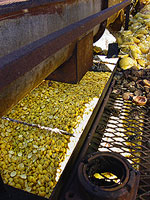 Members of the band Guster joined officials from the City of East Lansing on the Michigan State University campus this week to announce the growing use of biodiesel in the town, according to the National Biodiesel Board. Guster was in East Lansing for a performance at MSU as part of the Campus Consciousness Tour, which raises awareness in college towns about sustainable practices like using biodiesel. Their tour bus is fueled by B20, a blend of 20 percent biodiesel and 80 percent diesel.
Members of the band Guster joined officials from the City of East Lansing on the Michigan State University campus this week to announce the growing use of biodiesel in the town, according to the National Biodiesel Board. Guster was in East Lansing for a performance at MSU as part of the Campus Consciousness Tour, which raises awareness in college towns about sustainable practices like using biodiesel. Their tour bus is fueled by B20, a blend of 20 percent biodiesel and 80 percent diesel.
Plant Plans
Indiana – The Andersons Inc. is considering a third ethanol plant in Dunkirk, Ind. (Toldedo Blade) (see previous post)
Florida – United States EviroFuels LLC received a state permit to construct an ethanol production plant at Port Sutton. (Tampa Bay Business Journal) (see previous post)
Michigan – A company formed by former state Rep. Rick Johnson wants to build a $73 million ethanol refinery in Grand Traverse County’s Paradise Township. (Traverse City Record-Eagle)
Illinois – Marquis Energy LLC. of Hennepin and global investment and advisory firm, Babcock & Brown, have entered into a memorandum of understanding to construct, manage and provide investment financing for a two-phase development of a 200-million gallon fuel-grade ethanol facility. (News Tribune Online)
South Dakota – Not everyone in the community is thrilled over the $88 million Prairie Ethanol plant being built at Loomis, a town of 47 residents a few miles northwest of Mitchell. (AP-Aberdeen News)
Missouri – Bootheel Agri-Energy LLC announced its decision to purchase the option on approximately 160 acres at the Sikeston Business, Education and Technology Park. (SE Missourian)
First Fuel Cell Police Car
 Wayne State University in Detroit is the proud owner of the world’s first fuel cell-powered police car introduced this week by DaimlerChrysler. According to their release, the Wayne State University Police Department will operate the Mercedes F-Cell as a supervisor’s vehicle on and in the immediate vicinity of the campus, located in Detroit’s Cultural Center. Outfitted with a third-generation police radio, decals, lights and sirens, the Wayne State University Police Department F-Cell is a look into the future use of fuel cell vehicles. The demanding operation of a police car will produce valuable data to help develop fuel cell technology.
Wayne State University in Detroit is the proud owner of the world’s first fuel cell-powered police car introduced this week by DaimlerChrysler. According to their release, the Wayne State University Police Department will operate the Mercedes F-Cell as a supervisor’s vehicle on and in the immediate vicinity of the campus, located in Detroit’s Cultural Center. Outfitted with a third-generation police radio, decals, lights and sirens, the Wayne State University Police Department F-Cell is a look into the future use of fuel cell vehicles. The demanding operation of a police car will produce valuable data to help develop fuel cell technology.
Energy Secretary Promotes Energy Initiative
 U.S. Secretary of Energy Samuel Bodman made lots of friends in the hydrogen fuel cell business yesterday when he announced plans to award $50 million over the next three years in research grants to advance the technology. AP reports that universities, national laboratories and private companies will compete for the grants starting later this month. They are part of the Bush Administration’s goal of making fuel cells a viable technology by 2020.
U.S. Secretary of Energy Samuel Bodman made lots of friends in the hydrogen fuel cell business yesterday when he announced plans to award $50 million over the next three years in research grants to advance the technology. AP reports that universities, national laboratories and private companies will compete for the grants starting later this month. They are part of the Bush Administration’s goal of making fuel cells a viable technology by 2020.
While announcing fuel cell research grants in a speech to the Society of Automotive Engineers in Detroit, Bodman also called on automakers to produce more flex fuel vehicles. “It should be our common goal that E85 become a nationwide fueling option,” Bodman said. “In the coming days, I will be asking that we do more to make consumers aware of the flex-fuel option both when they are considering a new car purchase and for existing owners of flex-fuel vehicles.” The Renewable Fuels Association “welcomed the continued, full-throated support of the Bush Administration” for ethanol.
Bio Biking
 Environmentally-conscious bikers may be interested in easy riding with Ecorider, “the only production diesel motorcycles offered for sale to the public in this country.” According to an email we got from Dusty Beckstrand, western US rep for Ecorider, they have been contacted lately by biodiesel companies interested in the bikes, “which use a German, Hatz diesel engine that gets 125 mpg and the engines are multi-fuel capable.” As you can see by the picture, the bikes have wide tires for all-terrain travel. Dusty says he’d like to “present the bikes to Willie Nelson, Morgan Freeman and Daryl Hannah for their inspection and approval.”
Environmentally-conscious bikers may be interested in easy riding with Ecorider, “the only production diesel motorcycles offered for sale to the public in this country.” According to an email we got from Dusty Beckstrand, western US rep for Ecorider, they have been contacted lately by biodiesel companies interested in the bikes, “which use a German, Hatz diesel engine that gets 125 mpg and the engines are multi-fuel capable.” As you can see by the picture, the bikes have wide tires for all-terrain travel. Dusty says he’d like to “present the bikes to Willie Nelson, Morgan Freeman and Daryl Hannah for their inspection and approval.”
Small Company with Big Plans
 A California company is planning to become a major ethanol producer with some new backing. A release this week from Altra, Inc. announced that it has attracted some heavy-hitter investors – private equity firms Kleiner Perkins Caufield & Byers, Omninet Private Equity, LLC and Sage Capital Partners, L.P. along with two leading private equity funds focused on high growth companies in the energy sector — Angeleno Group, LLC and Khosla Ventures.
A California company is planning to become a major ethanol producer with some new backing. A release this week from Altra, Inc. announced that it has attracted some heavy-hitter investors – private equity firms Kleiner Perkins Caufield & Byers, Omninet Private Equity, LLC and Sage Capital Partners, L.P. along with two leading private equity funds focused on high growth companies in the energy sector — Angeleno Group, LLC and Khosla Ventures.
Founded in 2004, Altra is led by seasoned business leaders and veterans of the biofuels and energy industries. Altra acquires, develops and operates a portfolio of renewable energy projects throughout the United States. Altra is specifically focused on the production and sale of ethanol and biodiesel fuels that can help meet the world’s growing energy demands as it faces shrinking petroleum supplies that come from unstable regions of the globe. Political instability and increased world petroleum consumption have caused a corresponding rapid growth in the global demand for alternative and renewable fuels, which Altra believes will ultimately and permanently alter the dynamics of world energy markets.
Reuters did a story on the Altra plans.
A-peeling Fuel Research
 Now here’s an a-peeling idea for a cellulosic fuel source. Researchers at the Agricultural Research Service Citrus and Subtropical Products Laboratory in Winter Haven have been looking at the possibility of using citrus peels to make ethanol. According to this ARS story, citrus waste materials are rich in pectin, cellulose and hemicellusic polysaccharides, which can be hydrolyzed into sugars and fermented into alcohol. Most of this dried peel residue — a total of 1.2 million tons annually in Florida alone — is currently marketed as low-value cattle feed, despite its relatively high processing cost. They estimate that Florida’s citrus peel waste could yield up to 80 million gallons of ethanol per year.
Now here’s an a-peeling idea for a cellulosic fuel source. Researchers at the Agricultural Research Service Citrus and Subtropical Products Laboratory in Winter Haven have been looking at the possibility of using citrus peels to make ethanol. According to this ARS story, citrus waste materials are rich in pectin, cellulose and hemicellusic polysaccharides, which can be hydrolyzed into sugars and fermented into alcohol. Most of this dried peel residue — a total of 1.2 million tons annually in Florida alone — is currently marketed as low-value cattle feed, despite its relatively high processing cost. They estimate that Florida’s citrus peel waste could yield up to 80 million gallons of ethanol per year.
Plug In to Hybrids
 Found this good story on the Bioconversion Blog.
Found this good story on the Bioconversion Blog.
Flex-fuel vehicles can run on gasoline or ethanol or any blend in between. But the liquid fuel MPG is not very good. Hybrid cars can extend the MPG of an automobile by substituting electricity generated within the car in place of liquid fuel – but you need to run the car on fuel to build up the charge. Plug-in cars run on electricity alone without fuel and can be recharged overnight – but their range is not very good.
Why not build and buy Vehicles that are Hybrids that you can Plug-in for an Electric charge, but that are flex-fuel compatible? The consumer can then choose between the greatest range of options. That’s the vision of a group called Plug-In Partners and they are mounting a National Campaign to get automobile manufacturers to build the PHEV cars.
The campaign encourages on-line petitions, endorsements, fleet orders, rebates and incentives.
Ethanol Bill News
Ethanol bills were in the news in a couple of states today.
In Arizona, the Senate passed a bill which classifies E85 as a motor fuel and permits it to be used in Maricopa County. Maricopa County’s poor air quality has led to restrictions on the motor fuels that can be sold. But the Arizona Department of Environmental Quality endorsed the E85 blend. (The Arizona Republic)
In Kansas, Gov. Kathleen Sebelius Wednesday signed a bill encouraging the use of E85 fuel in Kansas. The bill reduces the motor vehicle fuel tax rate on E85 by 7 cents per gallon effective Jan. 1, 2007, for a new rate of 17 cents per gallon. Beginning July 1, 2020, the tax on E85 will drop to 11 cents per gallon, or 7 cents below the tax on most other fuels. (Wichita Business Journal)
MO House Moves Ethanol Bill
After a few amendments passed and a few defeated, the Missouri House of Representatives came to a consensus on an ethanol mandate bill for the state. The measure would require most gasoline sold in Missouri after the end of next year to contain a 10 percent ethanol blend – and here is the fine print – as long as the price to retailers is the same or cheaper than traditional gasoline. According to the Associated Press in the Kansas City Star, the price-dependent opt-out provision is the result of a compromise between agriculture leaders and petroleum marketers, who had argued that an inflexible mandate could lead to higher prices for consumers.

